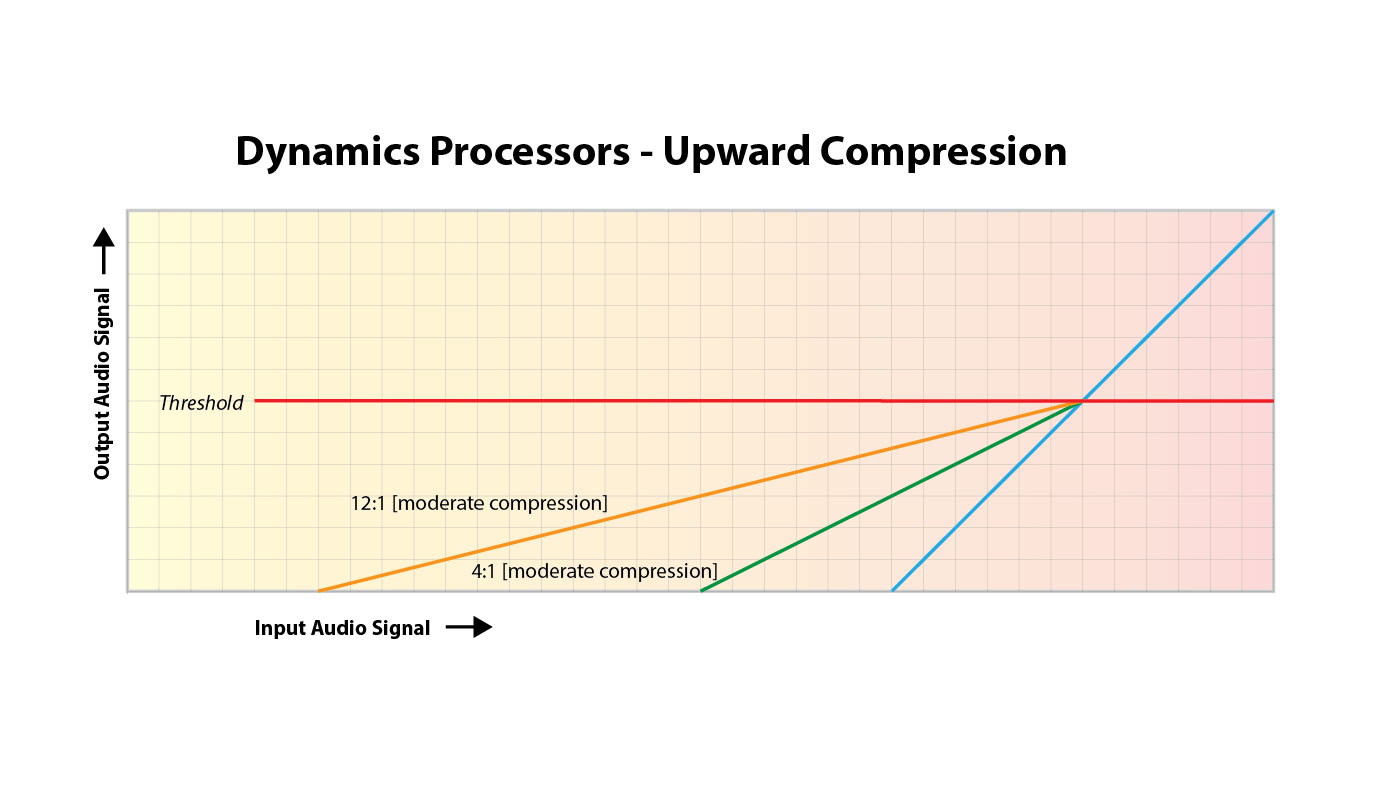Moving Up to Less Dynamic Range
There are two sides to every coin. What goes up must come down. Every action results in a reaction, right? So just as you can squash the dynamic range of an instrument, an entire track, or everything that comes through a broadcast, it is possible to narrow the dynamic range with a process that is the opposite of downward compression. It’s called upward compression.
Recall that downward compression is a process that attenuates the louder segments of a track by a specified ratio after they exceed a certain threshold. After the “peaks” have been brought down, another process called “normalize” raises the amplitude of all of the samples by the difference between the current highest peak and the maximum allowed by the word length in use. The result is that everything sounds louder.
But what if you wanted to maintain the contour of the louder elements in the target tune and wanted to merely increase the “lower level details” that are so often talked about in the audiophile lexicon? How could you do that…by applying a process that operates on those samples or segments that fall below a certain level or threshold. That means that “low level details” would be targeted for amplification while the louder stuff remains unchanged. Sounds like a better approach, right? Well, in fact it is.
Dynamic range is all about having AND using the bits in the 16 or 24-bit words of your system. Just because they are there doesn’t necessarily mean that they benefit your fidelity. They supply the potential to have tremendous differences between the loudest and quietest moments in your recordings, but there are many, many factors that complicate things. The background noise level of the hall, the repertoire, the equipment in use, the placement of the microphones, the signal path etc. must all be delivering dynamic range equal or more than the specifications of your system. They usually don’t.
So an upward compressor raises the lower level signals. Take a look at the diagram below:

Figure 1 – An input and output illustration showing the process of dynamic expansion. [Click to enlarge]
Using upward compression has the advantage of leaving the louder signals unmodified. Upward compression reduces the dynamic range of a piece of music by bringing up the low level signals…along with the noise floor. Of course, the noise floor comes up when a downward file is normalized so they neither process wins on that count but upward compression does have another critical advantage. It doesn’t overflow the number of bits available for processing.
Pulse code modulation slices us an analog signal into samples and each same gets assigned a value from the roughly 65K values available in a 16-bit system (or more as you increase the number of bits). But when those words are modified in a digital audio workstation, it’s necessary to have more bits to allow for processing. Such things as volume changes, equalization, sample rate conversion, pitch changes and lots of other DSP effects require some calculation room to guarantee that the captured dynamics are maintained.
Whenever you reduce the amplitude of a PCM digital signal, it means you’re shifting the bits in each sample to the right. If there are no bits there to absorb the rightward shift…the bits fall into the abyss. Having 32 or 48 or 56 bits in the processing environment means all of the data of each word has plenty or room to shift to the right and then back into play.
Upward compression is a process of making things louder so the shifting only moves to the left…so in some ways it’s preferable to downward compression. Of course, making the “low level details” louder as some audio professionals advocate is still distorting the natural sound of the music.


I suppose the old Dolby B and Dolby C tape recording technologies were an example of upward compression. Although in their case the purpose was to suppress the noise floor of the tape, and *maintain* the dynamics of the final playback material.
Dolby B and Dolby C were actually somewhat different. The “B” version that we all remember did boost the level of the high frequency signal during the recording stage and then reduced it by an equal and opposite amount on playback resulting in less hiss. Many of us didn’t bother with the decoding because the sound was much brighter.